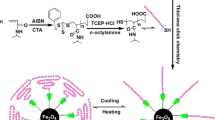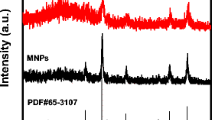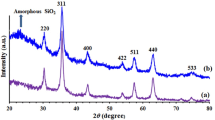Abstract
The synthesis of multilayered magnetic nanoparticles (MNPs) for use as a support in solid-phase peptide synthesis (SPPS) is described. Silanization of magnetite (Fe3O4) nanoparticles with 3-(trimethoxysilyl)propyl methacrylate introduced polymerizable groups on the surface. Polymerization with allylamine, trimethylolpropane trimethacrylate, and trimethylolpropane ethoxylate (14/3 EO/OH) triacrylate provided a polymeric coating and amino groups to serve as starting points for the synthesis. After coupling of an internal reference amino acid and a cleavable linker, the coated MNPs were applied as the solid phase during synthesis of Leu-enkephalinamide and acyl carrier protein (65-74) by Fmoc chemistry. A “high-load” version of the MNP support (0.32 mmol/g) was prepared by four consecutive cycles of Fmoc-Lys(Fmoc)-OH coupling and Fmoc deprotection. Successful synthesis of Leu-enkephalin was demonstrated on the “high-load” MNPs. Chemical stability studies proved the particles to be stable under SPPS conditions and magnetization measurements showed that the magnetic properties of the particles were maintained throughout derivatizations and SPPS. The MNPs were further characterized by high-resolution transmission electron microscopy, inductively coupled plasma atomic emission spectrometry, elemental analysis, and nitrogen gas adsorption measurements.





Similar content being viewed by others
References
Abboud M, Turner M, Duguet E, Fontanille M (1997) PMMA-based composite materials with reactive ceramic fillers. Part 1. Chemical modification and characterisation of ceramic particles. J Mater Chem 7:1527–1532
Albericio F, Tulla-Puche J (2008) The (classic concept of) solid support. In: Tulla-Puche J, Albericio F (eds) The power of functional resins in organic synthesis. Wiley-VCH, Weinheim, pp 3–14
Castro Franco AM, Kempe M (2004) Wide-pore CLEAR: Resins for solid phase synthesis and interactions of resin-bound ligands with biological macromolecules. In: Epton R (ed) Innovation and perspectives in solid phase synthesis & combinatorial libraries. Mayflower scientific Ltd, Kingswinford, pp 205–208
Cederfur J, Kempe M (2001) Development of wide-pore CLEAR supports for applications involving biological macromolecules. Polym Bull 46:381–387
Gan Z-F, Jiang J-S, Yang Y, Du B, Qian M, Zhang P (2008) Immobilization of homing peptide on magnetite nanoparticles and its specificity in vitro. J Biomed Mater Res A 84A:10–18
Hancock WS, Prescott DJ, Vagelos PR, Marshall GR (1973) Solvation of the polymer matrix. Source of truncated and deletion sequences in solid phase synthesis. J Org Chem 38:774–781
Hudson D (1999a) Matrix assisted synthetic transformations: a mosaic of diverse contributions. I. The pattern emerges. J Comb Chem 1:333–360
Hudson D (1999b) Matrix assisted synthetic transformations: a mosaic of diverse contributions. II. The pattern is completed. J Comb Chem 1:403–457
Ito A, Shinkai M, Honda H, Kobayashi T (2005) Medical application of functionalized magnetic nanoparticles. J Biosci Bioeng 100:1–11
Jun Y, Lee J-H, Cheon J (2008) Chemical design of nanoparticle probes for high-performance magnetic resonance imaging. Angew Chem Int Ed 47:5122–5135
Kaiser E, Colescott RL, Bossinger CD, Cook PI (1970) Color test for detection of free terminal amino groups in the solid-phase synthesis of peptides. Anal Biochem 34:595–598
Kempe M, Barany G (1996) CLEAR: A novel family of highly cross-linked polymeric supports for solid-phase peptide synthesis. J Am Chem Soc 118:7083–7093
Laurent S, Forge D, Port M, Roch A, Robic C, Vander Elst L, Muller RN (2008) Magnetic iron oxide nanoparticles: synthesis, stabilization, vectorization, physicochemical characterizations, and biological applications. Chem Rev 108:2064–2110
Lu A-H, Salabas EL, Schüth F (2007) Magnetic nanoparticles: synthesis, protection, functionalization, and application. Angew Chem Int Ed 46:1222–1244
McCarthy JR, Weissleder R (2008) Multifunctional magnetic nanoparticles for targeted imaging and therapy. Adv Drug Deliv Rev 60:1241–1251
Merrifield RB (1963) Solid phase peptide synthesis. I. The synthesis of a tetrapeptide. J Am Chem Soc 85:2149–2152
Sasikumar PG, Kempe M (2007) Magnetic CLEAR supports for solid-phase synthesis of peptides and small organic molecules. Int J Pept Res Ther 13:129–141
Scarberry KE, Dickerson EB, McDonald JF, Zhang ZJ (2008) Magnetic nanoparticle–peptide conjugates for in vitro and in vivo targeting and extraction of cancer cells. J Am Chem Soc 130:10258–10262
Stewart JM, Young JD (1984) Solid phase peptide synthesis, 2nd edn. Pierce, Rockford, IL, pp 105–106
Sucholeiki I, Perez JM (1999) New high loading paramagnetic support for solid phase organic chemistry. Tetrahedron Lett 40:3531–3534
Sucholeiki I, Perez JM, Owens PD (2001) New polyoxyalkyleneamine-grafted paramagnetic supports for solid-phase synthesis and bioapplications. Tetrahedron Lett 42:3279–3282
Sucholeiki I, Toledo-Sherman LM, Hosfield CM, Boutilier K, DeSouza LV, Stover DR (2004) Novel magnetic supports for small molecule affinity capture of proteins for use in proteomics. Mol Divers 8:9–19
Sun C, Lee JSH, Zhang M (2008) Magnetic nanoparticles in MR imaging and drug delivery. Adv Drug Deliv Rev 60:1252–1265
Szymonifka MJ, Chapman KT (1995) Magnetically manipulable polymeric supports for solid phase organic synthesis. Tetrahedron Lett 36:1597–1600
Acknowledgments
We thank Dr. Ian Snowball at the Department of Geology, Lund University, for help with magnetic analyses, Ms. Birgitta Lindén at the Department of Chemical Engineering, Lund University, for porosimetry analyses, Dr. Jakob Wagner at the National Center for High Resolution Electron Microscopy, Lund University, for TEM, and Mr. Tommy Olsson, Department of Ecology, Lund University, for ICP-AES. This work was supported by the Swedish Research Council and the Swedish Foundation for Strategic Research (INGVAR, Individual Grant for the Advancement of Research Leaders).
Author information
Authors and Affiliations
Corresponding author
Electronic Supplementary Material
Below is the link to the electronic supplementary material.
Rights and permissions
About this article
Cite this article
Norén, K., Kempe, M. Multilayered Magnetic Nanoparticles as a Support in Solid-Phase Peptide Synthesis. Int J Pept Res Ther 15, 287–292 (2009). https://doi.org/10.1007/s10989-009-9190-3
Accepted:
Published:
Issue Date:
DOI: https://doi.org/10.1007/s10989-009-9190-3




